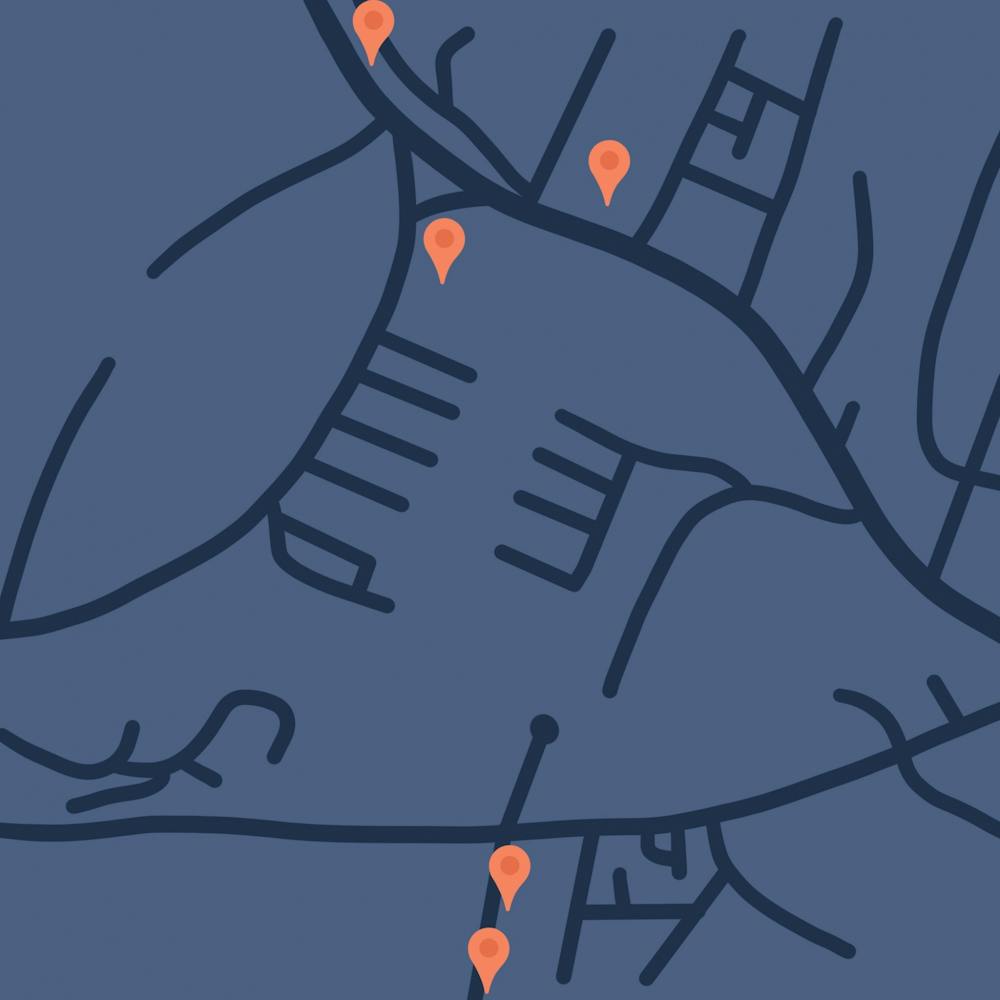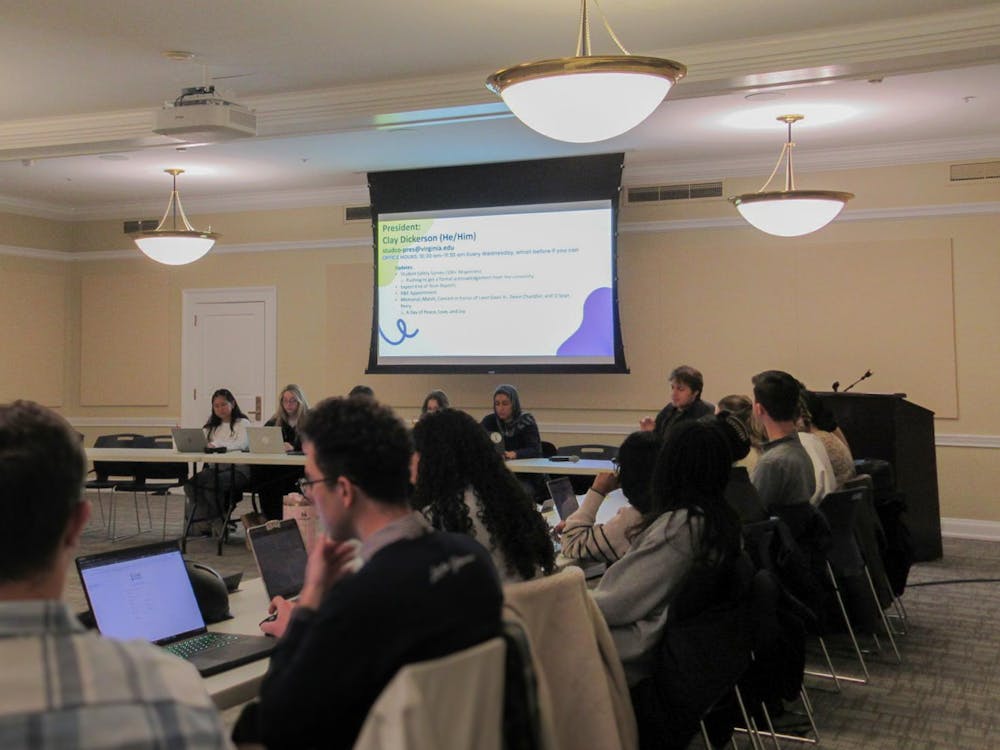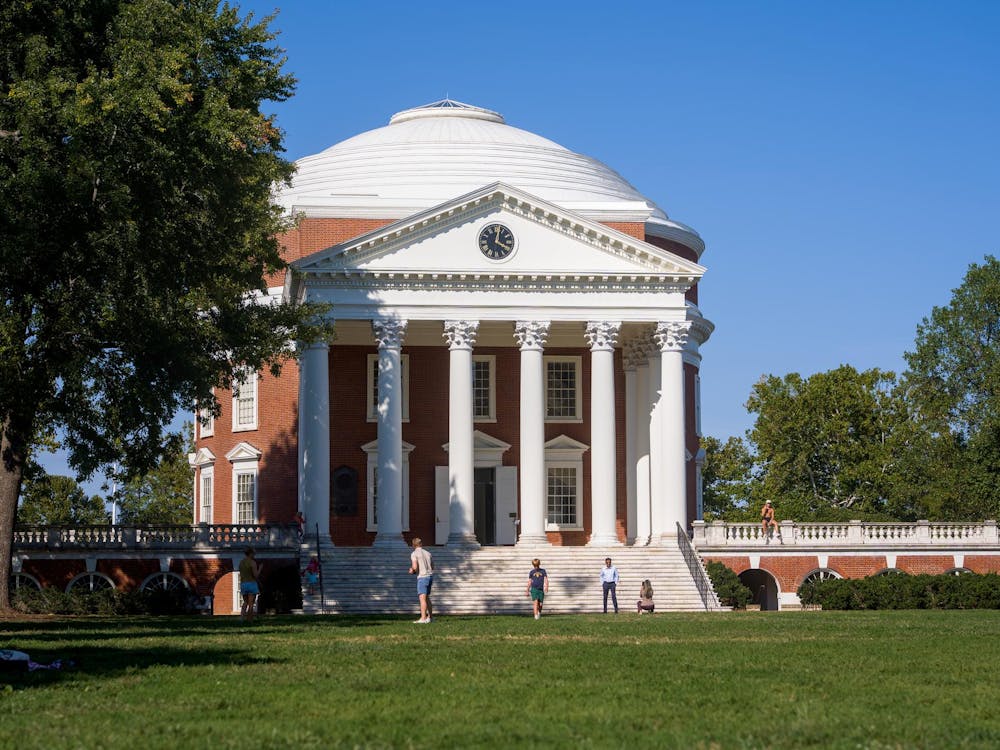The physical landscapes of the University and Charlottesville have undergone a number of physical changes over the past year, ranging from relatively small construction and design changes to broad initiatives that represent the University’s strategic goals and values. These changes — including major construction and capital renovations, new buildings, the removal of monuments and changes to businesses on the Corner — hold implications for the student body and the University and Charlottesville communities as a whole.
Capital Projects, Construction, Renovation
The University’s Major Capital Plan outlines 10 ongoing construction projects in academic divisions of the University, as well as nine approved for construction and four approved for schematic design. The cost of construction projects ranges from $3 million to $200 million.
Alderman Library Renewal
Construction on Alderman Library began in early 2020 and is scheduled to finish in fall 2023. Considered to be the University’s main library, Alderman Library was first constructed in 1938. The project, which is allocated $152.5 million dollars in the Major Capital Plan, will renovate the library’s existing 100,000 square feet and add an additional 130,000 square feet.
The decision was motivated in part by safety considerations and renovations will improve HVAC, electricity and fire suppression infrastructure. However, the renovations also aim to make the area more conducive to student use by expanding the spaciousness of the library stacks and adding mixed-use areas and study courts.
First-year Engineering student Christopher Joseph is president of First Year Council and representative for Student Council. Joseph said while many first year students are frustrated with the amount of construction taking place, others are looking forward to the outcomes of the projects.
“A lot of the responses I’ve seen [are] that they do look forward to what the construction is about, but they do notice that a lot of construction is going on at the same time,” said Joseph. “It is kind of noisy, and specifically the traffic in front of the chemistry building [...] does make it a bit slower for people to get around because it’s such a narrow walkway.”
According to Joseph, students have commented specifically about Alderman Library but ultimately understand the goals of the construction taking place.
With Alderman Library under renovation, students have one less library that they are able to go to, leading to complaints about the availability of study spaces. Walkways in front of the library have also been impacted, with pedestrians being required to take a detour around Clemons Library in order to reach nearby locations.
Emmet and Ivy Intersection
The University is also undertaking a multi-year project to transform the Ivy Corridor, a 14.5-acre parcel of land at the intersection of Emmet Street and Ivy Road. The first phase of the project focuses on landscape improvements, including storm water and utility improvements, widening sidewalks, planting tree lawns and adding bike lanes and bus stops along Ivy Road. In the Major Capital Plan, the University allocated $60 million to Phase I, which is projected to be completed in fall 2023.
The newly-improved corridor will eventually become home to the School of Data Science and a hotel and conference center.
The School of Data Science was approved in 2019 and its new academic building will be four stories and 61,000 square-feet, containing four “adaptive classrooms” in addition to office and research space and a green roof. The facility is expected to be completed by winter of 2023.
The final construction phase of the corridor, a new University Hotel and Conference Center, will begin in the winter of 2022 with an expected completion date of summer 2024. The proposed Center is almost 220,000 square feet, consisting of 25,000 square feet of Conference Center space as well as 217 guest rooms, a restaurant, cafe and a rooftop bar.
In June, President Ryan announced that thanks to a $50 million from the Karsh family that was matched by the University for a total of $100 million, the University plans to construct a building to house the Karsh Institute of Democracy. The building will be located on the Ivy corridor and will contain classroom space, an auditorium and research areas.
Third year Architecture student Lily Roberts is president of the National Organization of Minority Architecture Students at U.Va. and treasurer of the Student Planners Association. Speaking of ongoing construction around Grounds, Roberts said that mobility and accessibility have been the key points of contention among the student body.
Roberts also highlighted student concerns about the University cutting stops at what has historically been known as the Black Bus Stop. The stop, which is located at Garrett Hall on McCormick Road, became a harbor for Black students at the University and has since been recognized as a landmark of historical and cultural significance. In September, Student Council’s representative body denounced the planned cut as an “erasure of Black history at U.Va.” The stop was added back to the UTS bus route on Monday.
Construction along Emmett Street has led to lots of traffic, with vehicles needing to take detours around the area. Students have also complained about accessibility, specifically needing to walk up the long staircase from Emmett Street to U.Va. Bookstore in order to get to Central Grounds, according to Roberts.
When parts of Emmett Street were closed for two weeks in early November, cars and buses had to take a detour through Massie and Copeley roads, leading to increased transportation times.
Brandon Avenue Projects
The Board of Visitors approved the Brandon Avenue master plan in 2016, which outlines the construction of residential, academic and mixed-use University buildings. The plan also called for a “Green Street” streetscape redesign.
Brandon Avenue construction includes an upper-class housing project as part of a larger effort to create more on-Grounds housing for undergraduate students. The University has a working group dedicated to examining a proposal that would require students to live on Grounds for their first two years. The proposal intends to highlight the potential benefits of a longer residential learning experience and address concerns about the housing shortage in Charlottesville.
The Brandon Avenue master plan included the construction of the already-completed Bond House. The six-story building opened in fall 2019 and offers furnished four-bedroom apartments. Roberts affirmed the construction of Bond House aims to address the housing crisis and the lack of on-Grounds options after first-year that are “expansive enough for the student body.”
“I think that the University is trying to reckon with [the housing crisis], in creating more upperclassman housing and piloting second-year housing programs,” Roberts said.
The first phase of the master plan, which encompassed the construction of Bond House as upperclass housing, began in July 2017 and was completed in Aug. 2019. The Board of Visitors approved the second phase of construction for the Brandon Avenue upper-class residence hall project in March 2020.
The second phase, which cost approximately $114 million, will construct two additional five-story and six-story residence halls. The halls will include 350 student bedrooms, eight-bedroom apartments, a dining facility, communal spaces and 100 additional student parking spaces.
The Inn at Darden
Construction on the University Inn at Darden and Conference Center for Lifelong Learning at the University Darden School of Business Grounds began in Jan. 2021 as part of the Darden Grounds Master Plan. The inn, which is expected to be complete in 2023, received an initial gift of $20 million from Darden alumnus Frank M. Sands Sr. Gifts comprise $30 million of the $135 million dollars allocated to the project.
The inn will contain 12,000 square feet of meeting, innovation, and learning space as well as nearly 200 hotel rooms. The plan also calls for greenspaces to surround the inn and connect Darden with North Grounds.
The Darden School reached carbon neutrality in 2018 through a partnership between the University, the Darden School of Business and Dominion Energy and has committed to meeting or exceeding the University’s green building standards for the Inn.
Roberts noted that for future planning processes and construction, it is important to engage a variety of perspectives and ensure that younger students, who may not yet hold leadership positions, have an opportunity to give feedback as well.
“Whenever we have opportunities for student engagement, we often look at the same elected student body members to give their feedback and information. But ... those are oftentimes third and fourth-years who are about to graduate,” said Roberts. “It often-times feels like there are certain voices there in every room, and there are a lot of perspectives discounted when we’re making decisions.”
New Buildings
After seven years of planning and more than two years of construction, the University officially opened a new 165,000-square-foot Student Health building on Oct. 15.
The new building is located at 550 Brandon Avenue and will provide all services previously located in the Elson Student Health Center — Counseling and Psychological Services, Medical Services, the Student Disability Access Center and Health Promotion and Well-being,
The project cost the University $100 million, with $40 million in funding coming from an anonymous gift and $1 million from the family of Robert Hardie, vice rector of the Board of Visitors.
The building was designed to create a space for promoting the well-being of students, President Jim Ryan explained at the ribbon-cutting ceremony.
There are multiple student lounges available that are designed for more introverted students seeking a quiet space to relax or study.
“I think that the rooms are a good way to get away from the center of grounds and take some time to catch up on work and study,” third-year College student Zoë Cobb said.
Kitchens for classes in cooking and nutrition, a kinesiology center, all-gender restrooms, the Gordie Center for substance abuse recovery and private telehealth offices add to the list of new resources available to students.
The first floor of the building includes the Office of Health Promotion and the Student Disability Access center, along with a pharmacy and reflection rooms. The second floor is home to the Medical Services Administration, Medical Services Clinic, Medical Records and Insurance and Billing. On the third floor, a large living area is reserved for the use of students, along with an area for administration, information technology and kinesiology. Counseling and Psychological Services are on the fourth floor.
The new building is designed to serve as both a medical center with top-notch resources and a student center, where students can come to seek advice, receive help on mental health needs, and have a safe space to relax and study.
Chloe Marsh, third-year Education student and intern for the Office of Health promotion, said staff is appreciative of the new building and the benefits of more student-centered resources and spaces.
“I think a big difference is the old student health building was very functional, but I think that this one has a lot more areas for student well-being,” Marsh said.
Monuments moved
Over the summer, the City of Charlottesville removed statues of Robert E. Lee and Thomas “Stonewall” Jackson, as well as a monument of Meriweather Lewis, William Clark and Sacagewea. The University also removed the George Rogers Clark statue.
The successful removal followed years of advocacy efforts. Third-year College Zyahna Bryant first wrote a petition calling for the removal of the Lee statue in 2016, and City Council voted to do so later that year. This vote prompted white supremacists to flock to Charlottesville in August 2017 for the violent “Unite the Right” rally. A jury recently ruled that organizers of the rally must pay more than $25 million in damages.
The removal of the George Rogers Clark statue, however, was proposed by the University’s racial equity task force and approved by the Board of Visitors in September 2020. Advocacy for the statue’s removal had been similarly long standing — activists have emphasized the white supremacy and colonial violence encompassed by the monument, which depicts Clark on a horse, flanked by three soldiers, advancing on a group of Native Americans. In 2019, a local activist released a petition for its removal, and nearly 100 community members held a demonstration to outline demands beyond just the removal of the statue prior to the Board’s vote in September.
Businesses close and open on the Corner
The Corner has seen a string of closures over the past year, including the 68-year old College Inn. The restaurant served late-night pizzas and burgers to University students starting in 1953. As of this past summer, however, College Inn permanently closed in part due to the restaurant proprietor's decision to retire, along with their lease ending.
Staff reports reveal that corporate chain Chipotle Mexican Grill is buying the former College Inn location. Students, however, are critical of opening large businesses on the Corner.
“The Corner doesn’t need more large businesses,” third-year College student Eleanore Maxwell said. “What makes the corner so special is how unique the businesses are to Charlottesville.”
The Corner already boasts popular chains Insomnia Cookies, Chase Bank, CVS and Starbucks.
College Inn is not the only restaurant students’ had to say goodbye to — Littlejohn’s New York Delicatessen and Michael’s Bistro & Taphouse closed in the midst of the coronavirus pandemic.
“These restaurants have been a part of the University community for years,” third-year College student Sabrina Turbidy said. “It’s sad to see them go.”
The recent removal of Sheetz, however, may provide an opportunity for a local business to return to the Corner.
Roberts, who is a fellow with the University Meriwether Lewis Institute for Citizen Leadership, said the group’s discussions have examined the culture of the Corner and its extension beyond the student body into the Charlottesville community.
“With the pandemic, and especially with students not being here for so long and giving their dollars to these different restaurants and shops that have closed, it is really unfortunate to see that they’ve closed and to see them not necessarily being repopulated with more small local businesses,” Roberts said.
Emma Xu, fourth-year McIntire student and president of Enactus, an organization which provides pro-bono consulting to social enterprise businesses in Charlottesville, noted the importance of having students play a larger role in determining the businesses that go on the Corner.
“I think I’d honestly like to see more U.Va. student action without petitioning — more student voices going into what businesses are on the Corner,” Xu said. “It makes a lot of sense because the businesses on the Corner, they directly serve U.Va. students.”







